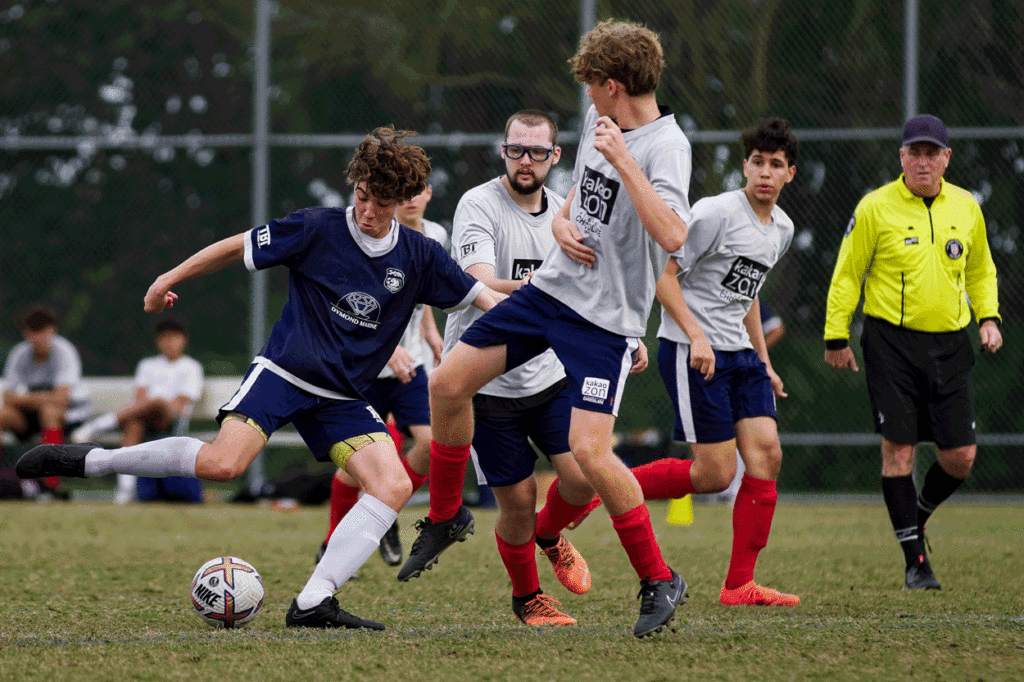Player development is central to SABR’s mission to serve our community as a total club for all members. SABR aims to maximize each player’s potential across every age and stage of the game.
Our youth soccer developmental approach ensures that everything introduced at the 4v4 level carries forward as players grow. From field size and exercises for soccer players to training structure and teamwork, each stage of youth soccer training builds on the last. Through a mix of small-sided games and the Play Practice Play model, players learn key soccer principles that form the foundation of 11v11 soccer such as spacing, soccer ball control, communication, and confidence. By the time they reach full-sided play, both the mental and physical aspects of the game are second nature.
How SABR’s Development Builds Stronger Players
At SABR, our foundation for building strong youth soccer players both on and off the field starts with proper training and preparation that lead into success during games and tournaments. These sessions are the foundation of our youth soccer lessons and soccer practice, helping every player strengthen their skills and understanding of the game.
Here are five ways our small-sided games and the U.S. Soccer’s Play-Practice-Play model helps prepare great 11v11 youth soccer players:
1. Field Awareness and Spacing
In small-sided games, players learn how to move with and without the ball in smaller spaces. This helps players develop better soccer ball control, react when a defender is close, and move into play-ready positions. These habits naturally translate into stronger spacing and positioning on a larger 11v11 field.
2. Passing and Team Shape
Incorporating the Play-Practice-Play model into our youth soccer training gives players a better feel for their passing and team shape. During each soccer practice, they get another chance to apply what they learned in the previous session, building key learnings through repetition. Players work on creating triangles, supporting teammates, and maintaining team shape, which are all essential to success in 11v11 soccer games.
3. Communication and Decision Making
Practicing with small-sided games means a smaller field and less space, which creates quicker pressure from the other team. This helps players understand how much time they have on the ball, when to move, and how to communicate with teammates. Players focus on knowing what they’re going to do with the ball and supporting their next teammate. Learning this in a small space gives players a huge advantage when they move up to 11v11, as their decision making becomes faster and more natural.
4. Building from the Back
Building from the back is essential as teams grow from 4v4 to 11v11. This approach allows players to get more touches on the ball, work with more teammates, and move up the field with purpose. When SABR implements the Play-Practice-Play model into soccer practice, youth players work on building from the back every session before learning more advanced tactics such as switching the field or calling for the ball. It’s one of the most effective exercises for soccer players because it builds patience, vision, and control.
5. Transition and Game Awareness
Small-sided games give players more touches and transitions per minute than a full match. This helps them switch from defense to attack quickly, anticipate plays, and stay engaged. The more they repeat these moments, the more natural it becomes when they move into 11v11 play. By that stage, players are confident in reading and reacting to the game.
Ready to Join a Youth Soccer Program?
SABR offers youth soccer lessons and training programs that guide players through every stage of their development. Learn more about our programs and see how your child can continue growing both on and off the field.
